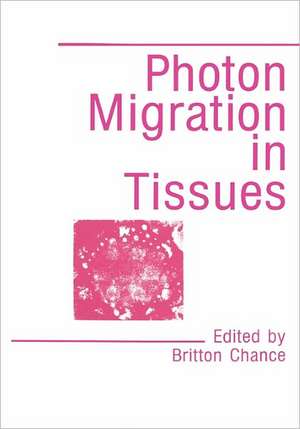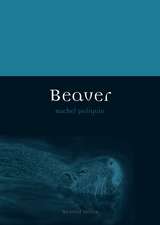Photon Migration in Tissues
Editat de B. Chanceen Limba Engleză Paperback – 30 noi 2010
| Toate formatele și edițiile | Preț | Express |
|---|---|---|
| Paperback (1) | 937.37 lei 6-8 săpt. | |
| Springer Us – 30 noi 2010 | 937.37 lei 6-8 săpt. | |
| Hardback (1) | 950.33 lei 6-8 săpt. | |
| Springer Us – 29 sep 1990 | 950.33 lei 6-8 săpt. |
Preț: 937.37 lei
Preț vechi: 1143.14 lei
-18% Nou
Puncte Express: 1406
Preț estimativ în valută:
179.36€ • 195.44$ • 151.14£
179.36€ • 195.44$ • 151.14£
Carte tipărită la comandă
Livrare economică 23 aprilie-07 mai
Preluare comenzi: 021 569.72.76
Specificații
ISBN-13: 9781441932150
ISBN-10: 1441932151
Pagini: 208
Ilustrații: X, 196 p.
Dimensiuni: 210 x 279 x 11 mm
Greutate: 0.37 kg
Ediția:Softcover reprint of hardcover 1st ed. 1990
Editura: Springer Us
Colecția Springer
Locul publicării:New York, NY, United States
ISBN-10: 1441932151
Pagini: 208
Ilustrații: X, 196 p.
Dimensiuni: 210 x 279 x 11 mm
Greutate: 0.37 kg
Ediția:Softcover reprint of hardcover 1st ed. 1990
Editura: Springer Us
Colecția Springer
Locul publicării:New York, NY, United States
Public țintă
ResearchDescriere
This book is formulated from a number of presentations made at a one-day workshop on the subject of Photon Migration in Tissues. The meeting was held in Philadelphia at the University of Pennsylvania, April, 1988. The workshop was an impromptu effort to bring together scientists to discuss photon migration in animal tissues and appropriate models. The rapid emergence of the ideas of Townes and Schalow in their invention of the then called maser, now laser opened up completely unexpected possibilities for biomedical research. Timing of rapid biochemical reaction, identification of unstable intermediates, spectroscopy of short lived fluorescent states were all goals to be expected and achieved. At the same time continuous light spectroscopy of tissue slices and of the myocardium, and eventually of the brain have the to the the neonate emerged over years. Shifting red end of spectrum, Butler and Norris clearly showed how transparent plant materials and the human hand could be illuminated in this region and Jobsis applied their idea to the neonate brain using a multiwavelength technique.
Cuprins
Summary Report of Workshop on Photon Migration.- 1. Theoretical Aspects.- A Random Walk Theory of Time Resolved Optical Absorption Spectroscopy in Tissue.- Tissue Optical Properties in Relation to Light Propagation Models and In Vivo Dosimetry.- Some Prospects for Adapting Fluorescence Instrumentation.- 2. Experimental Studies.- The Neonate Brain (NIR) and Breast Imaging using Transillumination.- Development and Validation of Multiwavelength Algorithms for In Vivo Near Infrared Spectroscopy.- Approaches to the Quantification of Tissue Pigments by NIR In Vivo using a Double Beam Method To Multicomponent Curve Fitting Analysis.- Ultrashort Laser Pulses Tomography in Semi-Opaque Media.- Breast Biopsy Analysis by Spectroscopic Imaging.- Photon Migration in Muscle and Brain.- 3. Instrumentation Aspects.- Experimental Time Resolved Methods.- A Tissue Model for Investigating Photon Migration in Trans-cranial Infrared Imaging.- Gigahertz Frequency-Domain Fluorometry: Resolution of Complex Intensity Decays, Picosecond Processes and Future Developments.- Authors.






